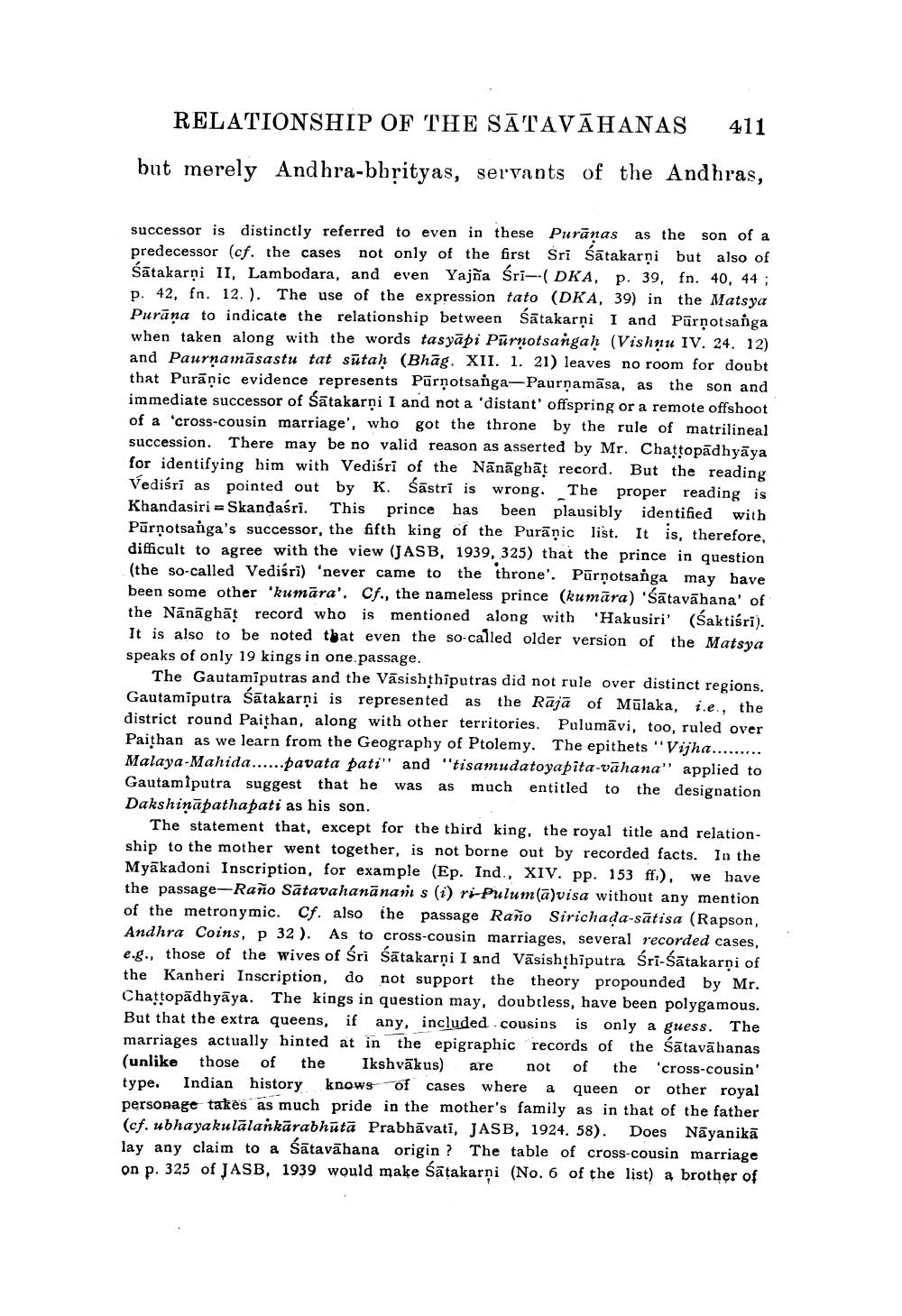________________
RELATIONSHIP OF THE SĀTAVĀHANAS 411
but merely Andhra-bhrityas, servants of the Andhras,
successor is distinctly referred to even in these Purānas as the son of a predecessor (cf. the cases not only of the first Sri śātakarni but also of Satakarni II, Lambodara, and even Yajña Sri-( DKA, p. 39, fn. 40, 44; p. 42, fn. 12.). The use of the expression tato (DKA, 39) in the Matsya Purāna to indicate the relationship between sātakarņi I and Pūrņotsanga when taken along with the words tasyāpi Pūrnotsangah (Vishnu IV. 24. 12) and Paurnamāsastu tat sūtah (Bhāg. XII. 1. 21) leaves no room for doubt that Purāņic evidence represents Pūrņotsanga-Paurņamāsa, as the son and immediate successor of Sātakarņi I and not a 'distant' offspring or a remote offshoot of a 'cross-cousin marriage', who got the throne by the rule of matrilineal succession. There may be no valid reason as asserted by Mr. Chattopādhyāya for identifying him with Vediśri of the Nānāghāt record. But the reading Vediśri as pointed out by K. Šāstri is wrong. The proper reading is Khandasiri = Skandasri. This prince has been plausibly identified with Pārņotsanga's successor, the fifth king of the Purāņic list. It is, therefore, difficult to agree with the view (JASB, 1939, 325) that the prince in question (the so-called Vediśri) 'never came to the throne'. Pūrņotsanga may have been some other 'kumāra'. Cf., the nameless prince (kumāra) 'sātavāhana' of the Nānāghāt record who is mentioned along with 'Hakusiri' (Saktisri). It is also to be noted that even the so-called older version of the Matsya speaks of only 19 kings in one passage.
The Gautamīputras and the Vāsishthiputras did not rule over distinct regions. Gautamiputra Satakarņi is represented as the Rājā of Mülaka, ie, the district round Paithan, along with other territories. Pulumāvi, too, ruled over Paithan as we learn from the Geography of Ptolemy. The epithets "Vijha......... Malaya-Mahida......pavata pati" and "tisamudatoyapita-vāhana' applied to Gautamiputra suggest that he was as much entitled to the designation Dakshiņāpathapati as his son.
The statement that, except for the third king, the royal title and relationship to the mother went together, is not borne out by recorded facts. In the Myākadoni Inscription, for example (Ep. Ind., XIV. pp. 153 ff.), we have the passage-Raño Satavahanānan s (í) ri-Pulum(a)visa without any mention of the metronymic. Cf. also the passage Raño Sirichada-sātisa (Rapson, Andhra Coins, p 32). As to cross-cousin marriages, several recorded cases, e.g., those of the wives of Sri Satakarni I and Vāsishthiputra Sri-Satakarni of the Kanheri Inscription, do not support the theory propounded by Mr. Chattopadhyāya. The kings in question may, doubtless, have been polygamous. But that the extra queens, if any, included.cousins is only a guess. The marriages actually hinted at in the epigraphic records of the sātavābanas (unlike those of the Ikshvākus) are not of the cross-cousin' type. Indian history knows of cases where a queen or other royal personage takes as much pride in the mother's family as in that of the father (cf. ubhayakulalankārabhūtā Prabhāvati, JASB, 1924. 58). Does Nāyanikā lay any claim to a sātavāhana origin? The table of cross-cousin marriage on p. 325 of JASB, 1939 would make Śātakarņi (No. 6 of the list) a brother of




